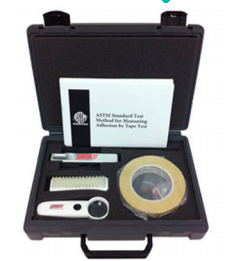
How Do I Choose My Ink?
While there are many options to consider with inks, one way to choose the right one is using the SAFE (substrate, application, finishing and end use) method. By prioritizing qualities of the ink’s adhesion in that order, manufacturers may more easily choose the best printing methods.
Adhesion to the Substrate
As identified by SAFE, ink-to-substrate adhesion is the top priority. Manufacturers must gather the tools to properly employ ink adhesion, then follow rules to make sure the inks stick.
The American Society for Testing and Materials (ASTM) test ASTM D3359 Method for Measuring Adhesion is an established adhesion testing method that most ink manufacturers use.
Why Won’t the Ink Stick?
 There are three primary reasons manufacturers have trouble getting their inks to stick. The first is substrate mismatch, which occurs when the ink is not designed to properly adhere to a certain substrate. Oftentimes substrates determine the type of resin used to make ink, and if there isn’t consistency here, then the inks will not stick properly.
There are three primary reasons manufacturers have trouble getting their inks to stick. The first is substrate mismatch, which occurs when the ink is not designed to properly adhere to a certain substrate. Oftentimes substrates determine the type of resin used to make ink, and if there isn’t consistency here, then the inks will not stick properly.
Next is surface contamination. It is not unusual for a substrate’s surface to be contaminated in cutting, shipping, handling or in storage, and manufacturers should clean substrates and produce a test print to identify contaminated areas.
Last is surface tension. Ink must flow out and make complete contact with the substrate, and if surface tension is not ideal, inks will have problems sticking. To be sure, the surface tension of the ink must be lower than that of the substrate.
What are You Printing On?
In many cases, poor adhesion results from issues with the substrate. Printers are compelled to explore unfamiliar sources for substrates to compete in today’s printing market to meet demand, which can expose issues with substrates like white plastics, glass, coated metals and powder-coated parts. There are many different versions for each substrate, so you must be aware of the necessary qualities that will allow inks to stick.
Read more in the SGIA Special Edition 2018 Industrial Journal.